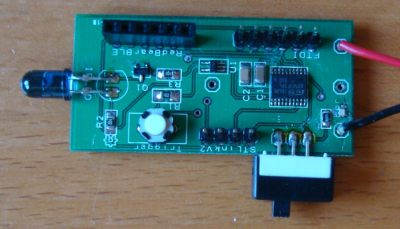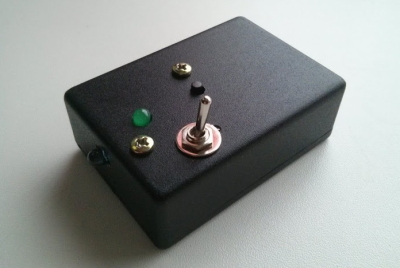The first remote control for a TV was the Zenith Space Command back in the 1950’s. Space Command used sounds at ultrasonic frequencies to control the set. It wasn’t until the 1980’s and the Viewstar cable box that infrared entered the picture. Remote controls spread like wildfire. It wasn’t long before every piece of consumer electronics had one. Coffee tables were littered with the devices. It didn’t take long for universal remotes to hit the scene. [Woz] himself worked on the CL9 Core device, back in 1987. Even in today’s world of smart TV’s and the internet of things, universal remotes are still a big item. Hackers, makers, and engineers are always trying to build a device that works better for them. This week’s Hacklet is about some of the best universal and IR remote projects on Hackaday.io!
 We start with [Harikrishna] and zmote. Zmote is an open source WiFi enabled, infrared, 360° remote control. That’s a mouthful. It might be easier to say it’s an ESP8266 and some IR LEDs. An ESP-01 module connects the device to WiFi and provides the 32-bit processor which runs the show. Learning functionality comes courtesy of a TSOP1738 modulated infrared receiver. The beauty of the Zmote is in the software. REST and MQTT connectivity are available. Everything is MIT licensed, and all the code is available on Github.
We start with [Harikrishna] and zmote. Zmote is an open source WiFi enabled, infrared, 360° remote control. That’s a mouthful. It might be easier to say it’s an ESP8266 and some IR LEDs. An ESP-01 module connects the device to WiFi and provides the 32-bit processor which runs the show. Learning functionality comes courtesy of a TSOP1738 modulated infrared receiver. The beauty of the Zmote is in the software. REST and MQTT connectivity are available. Everything is MIT licensed, and all the code is available on Github.
Next up is [Benjamin Kenobi] with TV Remote Control, Limited. Not everyone can operate the tiny buttons on a modern remote. [Benjamin] built this device for Easton, a special kid with a disability that impairs his motor skills. The 3D printed case holds two buttons – one for power, and one to change the channel. An Arduino Nano running [Ken Shirriff’s] IR library is the brains of the operation. The IR signal timing is hard coded for simplicity. One problem [Ben] ran into was the Nano’s high current draw, even in sleep mode. Batteries wouldn’t last a week. A simple diode circuit with a reed relay keeps the Nano shut down until Easton presses a button.
 Next we have [Nevyn] with OpenIR – Infrared Remote Control. A dead DSLR remote shutter release was all the motivation [Nevyn] needed to start work on his own universal remote control. OpenIR can be connected to (and controlled by) just about anything with a UART – a PC via an FTDI cable, a Bluetooth module, even an ESP8266. The module can be programmed by entering pulse length data through a custom Windows application. The Windows app even allows the user to view the pulses graphically, like a scope. The data is stored on an EEPROM on OpenIR’s PCB. Once programmed, the OpenIR board is ready to control the world.
Next we have [Nevyn] with OpenIR – Infrared Remote Control. A dead DSLR remote shutter release was all the motivation [Nevyn] needed to start work on his own universal remote control. OpenIR can be connected to (and controlled by) just about anything with a UART – a PC via an FTDI cable, a Bluetooth module, even an ESP8266. The module can be programmed by entering pulse length data through a custom Windows application. The Windows app even allows the user to view the pulses graphically, like a scope. The data is stored on an EEPROM on OpenIR’s PCB. Once programmed, the OpenIR board is ready to control the world.
 Finally, we have [facelessloser] with One button TV remote. This project may be the simplest open source remote control this side of TV-B-GONE. He wanted to build a simple remote control for his young daughter to scan between the various kids channels. A simple toggle switch turns the device on, and one button performs the rest of the magic. [Facelessloser] wanted to “move up” from an Arduino to an ATtiny85. This project became part of his ATtiny education. A custom PCB from OSH Park ties things together. A simple black project box keeps the electronics safe from tiny fingers – at least until she’s old enough to use a screwdriver.
Finally, we have [facelessloser] with One button TV remote. This project may be the simplest open source remote control this side of TV-B-GONE. He wanted to build a simple remote control for his young daughter to scan between the various kids channels. A simple toggle switch turns the device on, and one button performs the rest of the magic. [Facelessloser] wanted to “move up” from an Arduino to an ATtiny85. This project became part of his ATtiny education. A custom PCB from OSH Park ties things together. A simple black project box keeps the electronics safe from tiny fingers – at least until she’s old enough to use a screwdriver.
If you want to see more IR and universal remote��projects, check out our new infrared and universal remote projects list. See a project I might have missed? Don’t be shy, just drop me a message on Hackaday.io. That’s it for this week’s Hacklet, As always, see you next week. Same hack time, same hack channel, bringing you the best of Hackaday.io!


















The one button TV remote doesn’t need that toggle switch, just make the button turn on the ATTiny and have the ATTiny execute whatever the button would do. Use the EEPROM to keep track of variables.
I should make one housed inside of a small box with a gigantic red stop button on top as a ‘tv-b-gone’. Very good beginners project for me to try out. (I’m a newbie to microcontrollers and programming.)
Go for it!
Thanks for the encouragement!
I have a short list of possible starter projects to try out, and this one is perfect. :)
Universal remotes are fun for hackers. I have a window A/C that has a remote. I lost the remote, so I pulled out a universal remote and the booklet – and hacked the A/C in like 10 minutes flat. I then fired up an Arduino with an IR receiver and IR LED to have fun with the Arduino controlling the desired cold. What would be really fun would be a TV B Gone that first kills cable and satellite boxes first, so suddenly you get a bunch of “blue screens of death” then kills the TV sets. You’d have a TV B Gone Supreme. God forbid if someone develops a Juke Box B Gone….
Funny you should say that since that was kinda like my latest project https://hackaday.io/project/11076-randomremote . I couldn’t get TVbGone to compile with the latest arduino IDA http://www.righto.com/2010/11/improved-arduino-tv-b-gone.html
Good to know! Thanks for the links.
The Zmote looks fantastic with the exception of the visible screw hole; it could be covered with a cap/plug. Other than that nitpick I love the design and want one for myself!
That ‘screw hole’ would be the IR receiver
Why does it look like a Phillips head screw and not an IR sensor then?
http://robotechshop.com/shop/%E2%80%A2sensors/tsop-sm0038-ir-receiver/
Wow! I did not pay attention to something…
Thanks, and the sensor looks retro.
I believe the cross of metal is a shield to keep lower frequency (than light) noise out of the detector.
“Space Command used ultrasound to control the set.” There, I fixed it for you.
See, now you made Rodney use sarcastic to correct you.
Updated!
I’ve started this project: https://hackaday.io/project/12118-hackers-ir-remote
It’s a boost converter to run it from a single AA battery, an ATTiny45, a 5 way joystick and an IR LED.
From my experience with the Crazy Clock, I believe that putting the tiny to sleep between button pushes will keep the current draw low enough so that the battery will last a reasonable amount of time. Pin change interrupts will wake the tiny up when the joystick gets moved.
I’ve built the prototype, but haven’t had the time to write the firmware yet. Like the Crazy Clock, the idea will be that there will be a base library that runs most of the show and supply an API for code the user writes to handle everything.
This is why I base all my projects around a 6 D cell maglite, no power worries and it doubles as staff weapon. ;-)
+1
That’s funny, and you gave me a great idea.
Added you to the list! Nice start!
just about anything with a UART – a PC via an FTDI cable
Please just call them usb serial converters / cables or whatever. No need for trademarks.
Ever since the debacle where FTDI is blaming & annoying their customers for not wanting to pay absurd prices for their chips (which is the main reason of affordable clones) I avoid all FTDI products like the plague.
https://hackaday.com/2014/10/22/watch-that-windows-update-ftdi-drivers-are-killing-fake-chips/
https://hackaday.com/2016/02/01/ftdi-drivers-break-fake-chips-again/
Go eat your tail Mr ftdi.
These chips have never been “fake”. They were (are) just second sources. :)
Just out of curiosity, do windows users have to install drivers for CH340 or PL230x chip’s?
They all just work on my linux boxes :-).
Are FT230X chips fake prolific chips?
http://www.ftdichip.com/Products/ICs/FT230X.html
I will not forget.